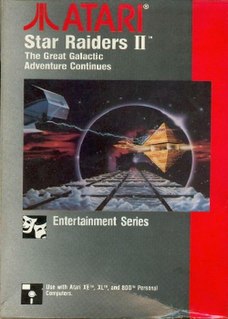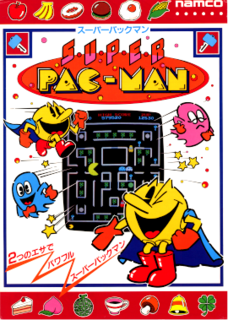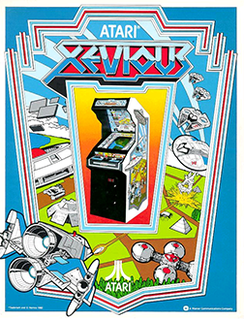 W
WAsteroids is a space-themed multidirectional shooter arcade game designed by Lyle Rains, Ed Logg, and Dominic Walsh and released in November 1979 by Atari, Inc. The player controls a single spaceship in an asteroid field which is periodically traversed by flying saucers. The object of the game is to shoot and destroy the asteroids and saucers, while not colliding with either, or being hit by the saucers' counter-fire. The game becomes harder as the number of asteroids increases.
 W
WBattlezone is a first-person shooter tank combat arcade game from Atari, Inc. released in November 1980. The player controls a tank which is attacked by other tanks and missiles. The game is considered to be the "first big 3D success".
 W
WE.T. the Extra-Terrestrial is a 1982 adventure video game developed and published by Atari, Inc. for the Atari 2600 video game console. It is based on the film of the same name and was designed by Howard Scott Warshaw. The objective is to guide the eponymous character through various screens to collect three pieces of an interplanetary telephone that will allow him to contact his home planet.
 W
WElevator Action is a 1983 action platform arcade game by Taito. The player assumes the role of a spy named Agent 17, infiltrating a 30-story building filled with elevators and enemy agents who appear from behind closed doors, with the goal being to collect the secret documents from specially marked rooms within the building, then escaping from the building. It ran on the Taito SJ System arcade system.
 W
WJr. Pac-Man is an arcade game, released by Bally Midway on August 13, 1983. It is based on Pac-Man and its derivatives but, like Baby Pac-Man, and Pac-Man Plus, was created without the authorization of Namco. This was one of several games that eventually led to the termination of the licensing agreement between Namco and Bally Midway in 1984. Unlike prior games in the series, the maze in Jr. Pac-Man scrolls horizontally and has no escape tunnels.
 W
WStar Raiders II is a video game released in 1986 for the Atari 8-bit family as a sequel to 1979's Star Raiders, which was the killer app for the Atari computers. The game was originally developed as part of a tie-in with the movie The Last Starfighter, which featured an arcade game of the same name as part of its plotline. Versions for the Atari 5200 and the Atari 8-bit computers were developed in 1984, although those were never released. Later the tie-in was dropped, and the game converted into a sequel to Star Raiders by changing a number of gameplay elements. The gameplay remained different from the original Star Raiders.
 W
WMillipede is fixed shooter video game released in arcades by Atari, Inc. in 1982. It is the sequel to the arcade game Centipede with more gameplay variety and a wider array of insects than the original. The objective is to score as many points as possible by destroying all segments of the millipede as it moves toward the bottom of the screen, as well as eliminating or avoiding other enemies. The game is played with a trackball and a single fire button which can be held down for rapid-fire.
 W
WStargate is a horizontally scrolling shooter released in arcades in 1981 by Williams Electronics. Created by Eugene Jarvis and Larry DeMar, it is a sequel to Defender which was released earlier in the year. It was the first of only three productions from Vid Kidz, an independent development house formed by Jarvis and DeMar.
 W
WSuper Pac-Man is a 1982 maze chase arcade game developed and published by Namco. It was distributed in North America by Midway Games. Super Pac-Man is Namco's take on a sequel to the original Pac-Man; Midway had previously released Ms. Pac-Man, which Namco had little involvement with.
 W
WTempest is a 1981 arcade game by Atari Inc., designed and programmed by Dave Theurer. It takes place on a three-dimensional surface, sometimes wrapped into a tube, which is viewed from one end and is divided into either 15 or 16 lanes, depending upon whether the tube's shape was closed or open, respectively. The player controls a claw-shaped "blaster" that sits on the edge of the surface, snapping from segment to segment as a rotary knob is turned.
 W
WTrack & Field is an Olympic-themed sports arcade game developed by Konami and released in 1983. The Japanese release sported an official license for the 1984 Summer Olympics. Players compete in a series of events, most involving alternately pressing two buttons as quickly as possible to make the onscreen character run faster. It was followed by Hyper Sports and other games in the series.
 W
WXevious is a 1983 vertical-scrolling shooter arcade game developed and published by Namco. In North America, it was published by Atari, Inc.. Controlling the Solvalou starship, the player is tasked with wiping out the Xevious forces before they destroy all of mankind. The Solvalou has two weapons at its disposal: an air zapper to destroy flying enemies, and a blaster bomb to destroy ground-stationed enemies. It ran on the Namco Galaga arcade system.